|
|
Mountain/Rock |
|---|---|
|
|
35.76250°N / 76.61583°E |
|
|
26000 ft / 7925 m |
|
|
Overview
If there's a mountain harder to climb than K2, it's considered to be Gasherbrum IV. The peak is 7925m and an extremely technical climb. Its sheer rock faces are relentless and the objective dangers are many. On top of that, it's located in a part of the world where the weather is very unstable. The impressive mountain is the first of the "big ones" you can see when walking in towards the Baltoro area. It's located at the intersection where the Baltoro glacier splits and Gasherbum IV is really looming over everything around.
There are two main attack routes. One is directly from relatively low altitude from the Baltoro glacier and the other one is from the huge glacier fields close to camp one of Gasherbrum I, II and III. Contrary to general belief Gasherbrum doesn't mean "shining wall". The name comes from the Balti words rgasha, which means beautiful and brum which means mountain. The other five peaks are close by and three (I, II, III) of them are slightly higher at 8068m, 8032m and 7952m respectively. Gasherbrum IV is ranked as number 17 on the list of the world's highest mountains.
The first westerners to see the peak from the upper reaches of the Gasherbrum glacier was famous explorer Francis Younghusband and his party when they in 1889 explored the area. A handful attempts have been made and very few have resulted in success. The first ascent was made in 1958 by a strong Italian team led by legendary climber Riccardo Cassin. The route went along the NE ridge where they encountered a lot of hard technical climbing as well as snow storms. Only two members of the team reached the summit; Walter Bonatti and Carlo Mauri. On the descent they encountered another blizzard and had to spend the night in C6 at almost 7700m. The way down to C5 at 7200m was very technical and dangerous and it was a really close call for Giuseppi de Francesch when he almost fell to his death. Later attempts In 1986 Australians Greg Child and Tim Macartney-Snape and American Tom Hargis made an impressive ascent via the mountain’s north-west ridge. Robert Schauer and Wojciech Kurtyka attempted the peak 1985, but never reached all the way to the summit. See jck's addition further down.
A strong Korean team tried the mountain in 1995 and Shin Sang-Man and Yu Hak-Jae made it as high as 7800m on the NW ridge. In the same period Slovenian solo climber Sveticic died during an attempt of the west face. In 1997 a Korean team climbed the Central Spur of the West Face. The persons reaching the summit were Bang Jung-ho, Kim Tong-kwan and Yoo Huk-jae. Another Korean team made the summit in 1999. Route: Northwest Ridge. Climbers: Kang Yeon-ryong and Yun Chi-won. A strong American/South African team consisting of Steve Swenson, Steve House, Charley Mace and Andy DeKlerk tried the west ridge but to little avail. jck adds: As far as I know: in 1984 Kurtyka and Kukuczka did their traverse of three summits on Broad Peak. It was their second time on the top(they made an "acclimatization" ascent in 1982 without the permission via normal route). So they wanted to make a new route on Broad Peak(because as you problably know Kukuczka wanted all his ascents to be made via new route or during winter season)-but Broad Peak wasn't their main goal on that expedition. The wanted to climb the "Shiny Face" on Gasherbrum IV. While they were approaching to the bottom of the wall something broke between them. Kukuczka claimed that Kurtyka didn't want to climb from undisclosed reasons (maybe poor weather). On the other hand Kurtyka claimed that Kukuczka didn't want to climb because Gasherbrum IV is "only" 7925 meter high so it's not an 8000 meter peak. Anyway: they went back before they started the real climb.
One year later Kurtyka came back on Gasherbrum IV with Robert Schauer-it was an epic ascent. They climbed all the wall but due to bad weather and fatigue they passed the summit ridge (it's pretty long) in the lowest point and didn't manage to climb the real top. ---- Aleksander Schwarzenberg-Czerny mailed me some additional info. The 3000m high Gasherbrum IV West Face was climbed by Robert Schauer and Wojciech Kurtyka from July 13 to 20, 1985. After reaching the North Summit, bad weather and extreme exhaustion forced them to descend, missing the main summit. Their climb was selected by Climbing magazine as the greatest Himalayan climb of the 20th century. ... Kurtyka himself was a bit sceptic of this call, asking how you can select the best route, or, say the best women of a century? On one hand, traverse from the South Summit to The Main Summit is flat (25m difference in height) and at usual weather poses no technical difficulty. On the other hand, it is quite likely they would not come live down after attempting it without food already since 2 days. This route remains unrepeated. Koreans in 1996 went much to the north of K & Sch route. Of interest, Kurtyka & Schauer went DOWN by Northwest Ridge, climbed UP one year later by Child, Macartney-Snape & Hargis. Although I have no access to the copy of the quoted Climbing magazine, you may verify your facts in the recent Canadian book (3 book prizes) by Bernadette McDonald 'Freedom Climbers'. She gives an account of Polish Climbers role in establishing winter and alpine-style climbing in Himalayas in 1970/80's 2008 The strong team from Spain comprising Alberto Iñurrategi, José Carlos Tamayo, Ferrán Latorre, Juan Vallejo and Miguel Zabalza made it to a secondary summit of Gasherbrum IV via the Australian-American route on the NW Ridge (the third ascent through this route). On descent, Latorre was hit by a falling rock and had a leg injury, but managed to reach BC and was evacuated by helicopter without further complications. They did not go to the main summit, as originally reported. Remark: Please inform me if you know more attempts and summits.
Getting There
Gasherbrum IV is a long way into the wilderness in one of the most remote parts of Pakistan. Sooner or later you have to pass Islamabad as this is the town where you get the permits for the peak. If an organizer has taken care of the arrangements for you, you can just relax and follow your guide through the country. If you want to arrange everything yourself, the following may be of help.
From Islamabad to The Northern Areas. Local buses serve Islamabad with Skardu (the normal starting point for the trekking) well. Catch a bus from NATCO or Masherbrum Tours from Pirwadai i Rawalpindi (twin city of Islamabad, 15 km away). The cost for the 22-30h journey is about 12 US$. A taxi from central Islamabad will cost you 200-300 Rps. Some buses stop overnight in Besham, some go straight through to Skardu. If you have booked a ticket on a direct bus, don't be surprised if you have to wait in Besham for some time. Usually this wait is for other buses to gather and also for the police/military to ready a convoy. There are almos always some minor unrest in Indus Kohistan and to play it safe, the authorities arrange a convoy for the night traffic. It's nothing to worry about, it's standard procedure in this area.
From Skardu to Gasherbrum IV. There are two routes to the peak from Skardu - via Askole or via Gondogoro Pass. The former is to recommend if you're not acclimatized. Gondogoro Pass is a mighty 5600m, so most trekkers and climbers use this route for the way back.
To Askole. A jeep ride takes 6-8h on partly miserable roads and the going price in the summer of 2005 was 3500-4000 Rps. In Askole you can either camp out in the wild or use the one of the camping places, which will cost you 100 Rps. Facilities includes toilets, running water and a grassy, walled camping area. The first camp site along the route is Jhula. It takes anywhere between 4 and 8 hours to reach Jhula from Askole and the trek is very straight forward. Most of the time you walk on good paths along a river. An early start is recommended as it gets very hot in this area. Two bridges where you have to pay a small fee have to be crossed. Jhula has shower cabins, running water, toilets and camp platforms. 100 Rps./night.
Normally, there is not a problem to reach Paiju the second day. The trek is harder as you sometimes walk in sand along the rivers and there are some ups and downs en route. Paiju has the same facilities as Jhula and the cost to camp there is also 100 Rps./night. The place can be very crowded in the high season and if you don't like that, just continue for another 20 minutes to the first stream or to where the glacier start, where a very good place to camp is situated. Fresh water available here.
The next camping place is Urdukas, which has very good views of the Trango group. The camp site is situated on a hillside with good camp spots. Facilities and price is the same as Jhula and Paiju. If you want to go further or a part of the way to Urdukas, remember you'll be camping on the actual glacier. Campspots can easily be found there as well, but in some parts there are half an hour in between good or/and safe ones. From here on the lenght of a normal day trip varies a lot depending on how the persons in the group feel. There are some camps along the way, but they are all very basic, consisting of shelters built of rocks.
Most groups stop at Goro II, some stop an hour before this camp, Goro I and some go all the way to Concordia.
Concordia, which could be one of the most beautiful places on earth is sadly full of garbage and human waste. To the left you can see Broad Peak and K2. Ahead of you Gasherbrum IV is looming and to your right is the impressive Mitre. No fees and no facilities in Concordia. Two alternatives from here 1). To the southern base camp of Gasherbrum IV. 2). To the Gasherbrum glacier base camp of Gasherbrum IV, located to the east at the very end of upper Baltoro glacier. This is the same base camp as the one used for G I, G II and GIII. 1). It's a very short walk from Concordia until you have to walk up the small and short glacier leading to the foot of the southern reaches of the peak. 2). Continue up along the upper Baltoro glacier. When heading out of Concordia, ask for directions as the route through some smaller serac fields aren't obvious. Ladders over some large crevasses here.
Follow the glacier until you're at the southern rach of Baltoro Kangri and head north towards Sia Kangri and Gasherbrum I. If you're tired, there are some smaller camps along the way, notably Camp Moorr. No facilities here, but good shelter. There's also an army post along the way. Don't flash your camera here, it will be confiscated! About 4-7 hours of out Concordia, you'll hit the Gasherbrum base camp, which is very spread out on a glacier ridge.
Trekking out via Gondogoro Pass
Gondogoro Pass (or La as it is in the local language) is sometimes stated to be the highest pass in the world and the altitude given on many maps are over 5900m. It's not that high, but at 5600m it's still a very impressive pass. Many teams choose to walk out this way because of the outstanding views from the pass summit. Masherbrum (7821m) is very close and to your NW you see the whole Gasherbrum group, Chogolisa (7665m), Baltoro Kangri (7800m) and a lot of other high beautiful peaks. To the north K2 and Broad Peak are visible. In the south the extraordinary Laila Peak can be seen.
From Concordia it's a long day's walk to Ali Camp. First you walk past Mitre Peak and head up the next valley/glacier on your right hand side. Watch out for rock falls when entering the valley and try to gain access to the icy part of the glacier as soon as possible. Better to walk up there then down in the scree. When approaching Ali Camp, watch out for crevasses. The "security team" of Ali Camp will scream at you, where and where not to walk. Ali Camp has a 100 Rps./night fee. Ridiculous prices for "nature preservation" (there's loads of garbage all over the place), "guiding services" (I never saw any guides when I walked over the pass) and "security" (some bad plastic ropes, attached in extremely bad way is to be seen close to the summit of Gondogoro Pass) has to be paid. For 1-3 persons it's 2500 Rps. For 4-8 persons it's 4500 Rps. The pass is privately owned. That is probably why this scam can go on as it does. My advice is to bugger the "guides" staying in Ali Camp about the garbage and not trusting the ropes at all. I was told the it would take 5-7 hours to reach the pass from Ali Camp. It took me 2.45. For an acclimatized mountaineer, this is probably normal. It can be very windy on top of the pass, as it is a lot of elevation drop on the SW side. Don't trust the ropes on this side either. It's quite steep on this side (30-45 degrees depending on year). Stay up high on the right hand side if no tracks. There are crevasses on the middle of the glacier further down.
The path gets really good before the little camp site of Xhuspang/Shispang, where you also can get very basic meals. The glacier gets more difficult to travel after the camp and when you have passed the first rocky part and entered the main valley, stay to the left all the time. Doing so makes you avoid all the large crevasses and the left hand side is also the side you leave the valley on. When at the bottom of the first valley, take a left and enter some very nice meadows with yaks. Excellent views of sharp peaks. Some tricky, slide sections have to be passed. The walk gets easier again when heading down the lower part of the Gondogoro glacier towards Shaishcho. In this little settlement you can eat and pitch your tent under nice-smelling wild roses. 100 Rps./night per tent. From here it's a very easy 3 hour walk to Hushe. The Hushe - Skardu road is of awful condition for the first couple of hours. In the summer of 2005 the road had been badly cut away by a big river and all travelers had to walk over a wild river on small logs. Other jeeps were waiting on the other side. Lots of apricot orchards followed. From close to Khaplu the road is asphalt all the way into Askole. Count on 5-8 hours from Hushe to Askole.
Red Tape
Visas: Visas are required by nationals from most European and English-speaking countries. Validity period and cost varies a lot depending on which passport you carry. Some Pakistani Embassies around the world Visa extensions are available in most major cities in Pakistan, but should be avoided in the really large cities as it can be a long and nerve-wrecking experience. For Gasherbrum IV climbers, Skardu is a recommended place for extensions. See also the Skardu section Permits for Gasherbrum IV You need a permit to climb the peak, which you can get hold either via the Ministry of Tourism or via an expedition agent. The fees were dropped to half of the old price some years back and the going prices for 2005 are as follow:
- K2's royalty fees: 6000 USD for a team of seven, 1000 USD each additional climber.
- All other 8000ers, Gasherbrum I and II, Nanga Parbat, and Broad Peak: 4500 USD for a team of seven, 750 USD each additional climber.
- 7500 to 8000 meters: 2000 USD for a team of seven, 250 USD each additional climber. Gasherbrum IV is of course to be found in this price category.
- 7000 to 7500 meters: 1250 USD for a team of seven, 200 USD each additional climber.
- 6000 to 7000 meters: 700 USD for a team of seven, 100 USD for each additional climber. A trekking fee is also appliciable in the Gasherbrum IV area. It's US$50. This only applies if you arrange the walk in by yourself. If you join a commercial expedition you don't have to think about the fees for the liaison officer (LO) which is a must in this area of Pakistan. If you walk in via Askole, you need a LO all the way from the military checkpoint some hours out of Askole. If you choose the Gondogoro Pass/Hushe option you can walk in without a LO. When you climb Gasherbrum IV, every group needs to have a LO attached and he will follow you all the way to base camp. If going independently, you're supposed to pay the salary for the LO. Here's the full story, which also give you info about the obligatory briefing and de-briefing. An environmental fee of $200 also have to be taken into account. There's a refundable bond of $6000 which most expeditions have to pay. Count on it. I was probably just lucky no one asked me about it.
2010
Karrar Haidri, representing the the Executive Council Alpine Club of Pakistan forwarded me the following information. The Pakistan Ministry of Tourism has announced that the 50% Royalty fees of Mountain and other concession will continue in 2010. In super session of all previous notifications regarding announcement of concessions for Mountaineering and Trekking, it is hereby decided to charge: 1. Zero royalty fee for Peaks up to 6500-M during 2010 2. 10 % royalty fee on mountains situated in Chitral, Gilgit and Ghizar except on Spantik/Golden Peak. 3. 05 % royalty fee on all peaks during winter season (December- February) 4. 50% discount on royalty fee will continue during the year 2008 on all peaks except as mentioned in (1.) and (2.) above. 5. The services of an LO will not be required by expeditions outside the Baltoro region. The original prices: 1 K-2 8611m $12000 for 7 member for additional member $2000 2 8001-8500m $9000 for additional member $1500 3 7501-8000m $4000 for additional member $500 4 7001-7500m $2500 for additional member $400 5 6501-7000m $1400 for additional member $200 6 Up to 6500m $1400 for additional member $200When To Climb
June to September is the normal climbing season. Winter attempts have been made on some peaks in the area, but the success rate is very low and none of the really high peaks have been summited in the winter time so far.![Gasherbrum IV]() G4 and G2 from Urdukas camp. Photo taken and submitted by besucher01.
G4 and G2 from Urdukas camp. Photo taken and submitted by besucher01.Camping
It's allowed to camp anywhere along the route to Gasherbrum IV. Most climbers who go to the area have bought a package deal from an organizer and therefore a high majority of campers stay in the official campsites along the way. Some of them are clean and well-equipped places, some looks more like garbage dumps (Ali Camp and Concordia) and some are only detectable by some spartan wind shelters built by piled up rocks. Apart from the camps at Paiju, Jhula and Urdukas there is no reason to stay at the official places as they often are crowded and noisy places. Pitch your tent anywhere, but be careful with the water conditions close to places where many people camp or have camped. In the main Gasherbrum base camp the liaison officers are very strict about where you camp. This is because of its sensitive location close to both the Indian and the Chinese borders. Normally you have to camp where the rest of your expedition and LO camp.Mountain Conditions
There are many expeditions going to the other two Gasherbrums over 8000m and as Gasherbrum IV shares the same base camp there will be plenty of teams aroung you. Many of them have satellite communication capability and many of them are also online on a daily basis, i.e. you can get plenty of info about the weather. The K2 weather report also apply for Gasherbrum IV Main site of Adventure Weather.com The Pakistani army people on the Baltoro glacier keep a close check on the weather. Another good source of info, but let you LO make contact with the army base, as it’s not a good idea to walk up there by yourself.Books
I only know about one book specifically dealing with Gasherbrum IV. It's called La Splendida Cima, is written by Fosco Maraini and has ISBN 8878081272. Nelson adds: The English version of Maraini's book is titled Karakoram - The Ascent of Gasherbrum IV. It was published by Viking Press, New York, in 1961, and is available on used book sites. I think it is one of the best mountaineering books ever written. Greg Child's book "Mixed Feelings" has info about the Gasherbrum IV climb and also a chapter about Kurtyka. ISBN 0-89886-363-5 Kukuczka didn't make a "real" attempt on Gasherbrum IV, but there's a short section about the story in his fantastic book - My Vertical World, where he tells you the story about climbing all the 14 8000'rs. New routes or winter ascents only. ISBN 0340534850 or 0898863449 Ben Jammin recommends: For an in depth article about the peaks, see Alpinist #2. Old issues can be ordered from the publication's HQ. Walter Bonatti's absolutely fantastic book The Mountains of my life dedicates a chapter to the first ascent of the peak. In 2018 a book about Bonatti's climb of the mountain was released. La montagna scintillante.Porters
Contrary to what some organizers are telling you, you can arrange the trek all by yourself. The porter salary system was strict and worked fine until 2004, when massive amounts of climbers arrived for the K2 anniversary. A shortage of porters made some organizers desperate and they had to bid over the governmentally fixed prices. This created havoc and the whole porter salary system collapsed. The cost for a porter is now down to your bargaining skills. Officially it should be roughly 2830Rps. to Gasherbrum IV base camp, but count on paying as much as 4500Rps. This is without food. You can either go and buy food for the porters by yourself or hand over roughly 1300-1500 RPs./porter. Porters can be found in Askole, but if there are a lot of expeditions leaving when you get there, there's a high risk there is none available. Better book beforehand. The organizers are not very happy to help you out with this, as they want to include you in a group, but the small hotels in Skardu can usually help you. The price mentioned above is the full price, which include sunglasses, gloves etc. for the porter. What is not included in the price are the below items and you have to supply the group of porters with the following: - A kerosene stove
- Kerosene
- A tarp or a sheet of thick plastic which serves as a tent/shelter.
- Food All the above is best bought in Skardu. Food/porter 1300-1500Rps. The rest on the list 600Rps. (10 litres of kerosine). You can choose to pay the food money directly to the porters, or you can walk around with them and buy the food. Discuss it with the porters and come to an agreement. If you walk out via Gondogoro La/Pass try to find porters living in Hushe. The porters coming from the lower parts of the Baltoro glacier are much more prone to strike or turn around then the Hushe porters. The latter just want to have the job done/going home and are very seldom creating any trouble.
Skardu
Skardu is a little town where you'll spend a day or two and is the last outpost of "real civilisation". Some info that may be useful. - You can extend your visa here, regardless of what some organizers tells you. Go to the DP (Deputy Comissioner) Office. It takes an hour or two to get the one month extension. Prices depends on your nationality. The DP Office is to be found in the nothern end of town, close to the K2 Guest House.
- There are plenty of hotels in Skardu. The top end places are K2 Guest House and Masherbrum Hotel. The former is known for it's cozy garden and the latter for over-priced food. Prices ranges in between 1500-2000 Rps./night. Cheaper alternatives are to be found along the main street. A good value hotel is Gasherbrum Hotel on the main street. 300 Rps./night for a large double is a good deal and the food in the hotel's restaurant is excellent and the portions are monstrous of size.
- Camping and mountaineering shops sells everything you can find in their equivalents in the west. Prices varies. Gas canisters for example, are expensive, but down-suits can be bought for 200US$! Almost everything here is second hand.
- Food shops. There are plenty of them along the main street. Don't expect to find much more than the staples. You can find all the necessary food here if you're not picky and can put up with pasta, soups, porridge etc. for the weeks at Gasherbrum IV.
- If you hire your own porters, you better buy the stuff they need in Skardu. Further up the valleys it'll be way more costly and it's not 100% you'll find what you look for. See the porter section for more details about this.
Commercial Expeditions
There are a lot of companies which can offer you a package deal for all the higher peaks in Pakistan. As Gasherbrum IV is such a difficult peak and demand is extremely small, very few organizers have it mentioned in the standard program. I choose to list the ones I personally have encountered on my journeys. Random order. Local organizers Hushe Treks & Tours Local organizer which has been around for a long time. Nazir Sabir Expeditions Supposedly the best organizer, according to many Pakistanis. A bit more costly than the average organizer. Karakurum Treks & Tours Another company with lots of experience and good reputation. Karakurum Magic Mountains A quite new company with great services. Karakorum Explorers Small but experienced company. Saltoro Summits SP member Karrar's company. Foreign organizers Jagged Globe Base: UK. Footventure Base: UK. Tikmountain Base: Italy. Recommended! Amical Base: Germany. Useful addresses and information. North Pakistan tours Ishaq Ali Geologist Po Box 463 Islamabad Pakistan Alpine Club of Pakistan Jinnah Stadium, Pakistan Sports Complex, Islamabad.PAKISTAN 44000 Tel: 92-51-9208963 http://www.alpineclub.org.pk/Basic Information About Pakistan
Money & Costs Currency: Pakistani Rupee. 141.60 Rps = 1 US$ in April 2019.Relative costs: Road side restaurants: US$ 0,5-1,5 Budget meal: US$2-3 Moderate restaurant meal: US$3-8 Top-end restaurant meal: US$5-10 Budget room: US$1,5-5 Moderate hotel: US$10-15 Top-end hotel: US$22 and up By staying in hostels or dorms and eating like a local you can get by on as little as US$3-10 a day. If, however, you were looking for a moderate touch of luxury you could spend as much as $30-40 a day which could get you accommodation that included a satellite T.V., a desk, a balcony, and a spotlessly clean bathroom. As in any place you can spend as much as you like to live in the lap of luxury and stay in swanky hotels. It's worth noting that rooms and food are cheaper in the north than in the south. Both travellers cheques and cash are easy to change throughout the country, but commissions on cheques can be high. Apart from top-end hotels most places won't accept credit cards as payment although you can often use them for cash advances at western banks. Facilities for validation seem better for Visa then Mastercard. Occasionally a tattered note will be firmly refused as legal tender, and often in the smaller towns the appearance of a 1000 or 500 rupee note will cause consternation and an inability to provide change so make sure you get some smaller notes when buying your rupees. A reliable place for using Visa/Mastercards (ATM and cash withdrawals) is the Citibank in the Blue Area in central Islamabad. - Tipping Baksheesh isn't so much a bribe as a way of life in Pakistan. It can apply to any situation and is capable of opening all sorts of doors, both literal and metaphorical. Anything from a signature on a document to fixing a leaking tap can be acquired through the magic of baksheesh. Most top-end hotels will automatically add a 5-10% service charge to your bill so any extra tipping is entirely up to you. Taxi drivers routinely expect 10% of the fare, and railway porters charge an officially-set Rs 7. The only time that a gratuity might not be welcome is in the rural areas where it runs counter to Islamic obligation to be hospitable. As everywhere else, make sure the tip is not over the top. It only makes it hard for both future travellers and the locals. Be sure to read the situation right before using the baksheesh way. Some officials and army personal can be very touchy and it can really backfire offering the wrong person a baksheesh.
- Bargaining If baksheesh is a way of life, bargaining is a matter of style, particularly in the many Pakistani bazaars. Unlike the western hesitancy for bargaining, shopkeepers in Pakistani love to bargain as long as it's done with style and panache. Bargaining usually begins with an invitation to step inside for a cup of tea followed by a little bit of small talk, a casually expressed interest by yourself in a particular item, a way-too-high price mentioned by the seller, a way-too-low counter offer by yourself and eventually, after much comic rolling of eyes, a handshake and mutual satisfaction for both parties. Bargaining should always be accompanied by smiles, good humour and an ability not to get fixated on driving the price into the ground.
- Climate in the different provinces The best time for travelling to Pakistan depends on which part of the country you intend to visit. Generally speaking the southern parts of Pakistan including Sind, Baluchistan, Punjab and southern NWFP are best visited in the cooler months between November and April. After that it gets uncomfortably hot. The northern areas like Azad Jammu Kashmir, and northern NWFP are best seen during May to October before the area becomes snowbound. The weather may be a little stormy during this time but the mountain districts are usually still accessible.
- Ramadan Try and avoid Pakistan during Ramadan, the Muslim month of fasting which, usually occurs sometime during the months of December to early January. This is because a fasting Muslim is an understandably cranky Muslim, and you may find yourself involuntary joining in the fast because activity is kept to a minimum and food is hard to find during daylight hours. Pakistanis are usually very understanding when it comes to westerners who aren't muslims. Even if there are no tea or food served to muslims, these items are most of the time readily available for believers in other faiths.
- Security The security situation in Pakistan deteriorated through 1997, with areas previously considered safe experiencing the same sort of violence and crime as in the long-troubled Sind region. As well as the danger of being caught up in sectarian skirmishes, travellers have been the specific target of violence in Karachi and Lahore. Sind, the region in the south of Pakistan which includes Karachi, was known as the `Unhappy Valley' or the `Land of Uncertainties' by ancient travellers. Switch to the present day and news of curfews, foreign kidnappings and atrocities between the two main ethnic groups - Sindhis, the province's indigenous inhabitants, and the Mohajir, Muslim refugees from India - suggests its former name is still not out of place. With robbery, smuggling and gun-running amongst Sind's biggest industries, the province remains a highly dangerous place to visit. Travel to Sind as well as to the North-West Frontier Province, Punjab and Baluchistan should be undertaken with caution and only after consulting a national foreign affairs department prior to departure or a consulate in Karachi for current information. Many low end hotels are infamous for theft from the rooms. The Northern Areas are usually very safe and out of a climbers point of view this is the most important issue. The worst you probably encounter is snotty kids throwing a rock or two and a really annoying feature is the "one-pen-kids". Please do not encourage this behaviour by handing out gifts willy nilly. It only creates greed, beggary and a hell time for forthcoming travellers. If you want to give pens, hand it over to the local teacher/local.
- Health Shots against dengue fever, hepatitis A, malaria and, in rural areas, Japanese encephalitis are recommended. The tap water should be avoided all over Pakistan. Giardia and amoebic dysentery is endemic all over the country and Flagyl (metronidazole) is one of the more essential drugs to bring. Miscellaneous Time: GMT/UTC plus five hours Electricity: 220V, 50 Hz Weights & measures: metric Tourism: 424,000 visitors
- One of Pakistan's biggest newspapers online
- Pakistan's official site for tourism
External Links
- Nice photos and some info on this mountain photography page.
- Pictures from a trek of Baltoro


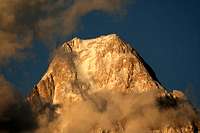
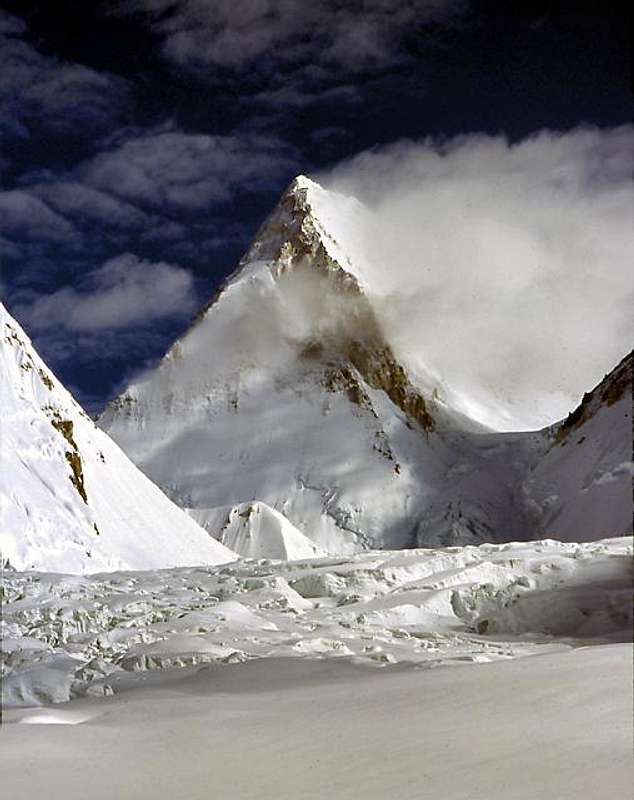
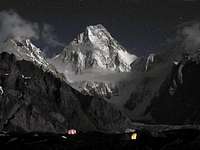
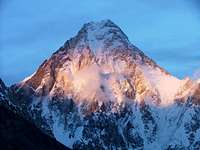
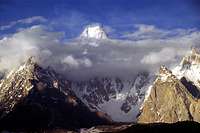
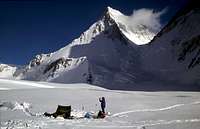
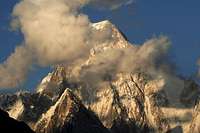
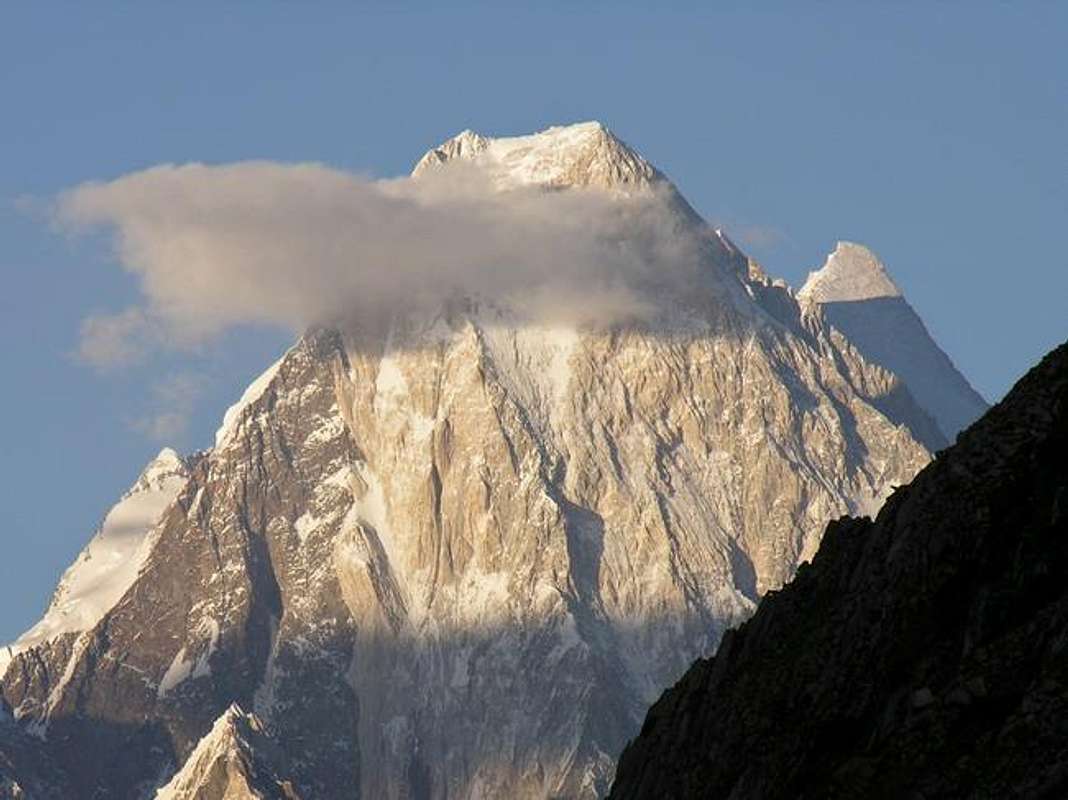



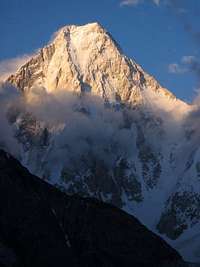
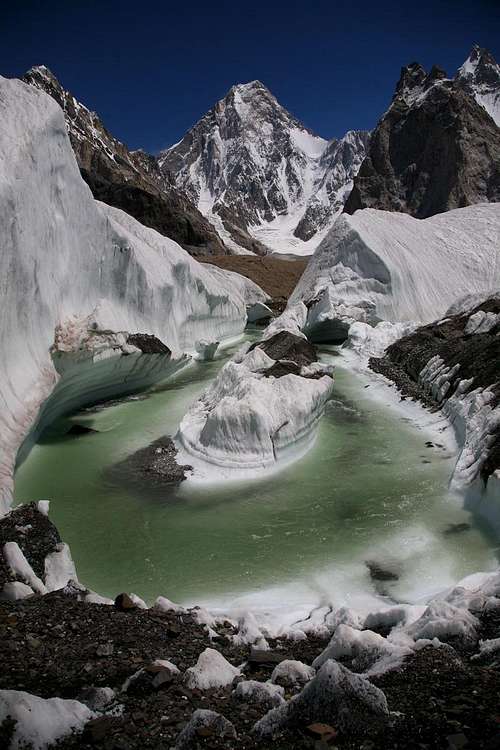
Damien Gildea - Mar 11, 2009 8:15 am - Hasn't voted
CorrectionsYou have Kurtyka/Schauer for "1994 & 1995" but they did their climb in 1985. Bonatti 1958 route is NE ridge, not N. Spanish 2008 did not go to main summit, as originally reported. D
Corax - Mar 11, 2009 10:24 am - Hasn't voted
Re: CorrectionsThanks Damien. Corrected.
eza - Mar 17, 2009 6:42 am - Voted 10/10
Just a minor detail...the 2008 spanish climber name is Miguel Zabalza (not "Zabalaza") ;)
Corax - Mar 18, 2009 10:52 am - Hasn't voted
Re: Just a minor detail...Thanks for the info. I will change it right now!
Baarb - Nov 24, 2009 1:27 am - Voted 10/10
More ascent info?Appears to be a couple more climbs (1997, 1999) listed on the Wikipedia page http://en.wikipedia.org/wiki/Gasherbrum_IV which largely references Alpinist Newswire. The coordinates seem to be a little off too, at least vs. the Google base-map. The Gasherbrum I page appears to also need as per this page: "Contrary to general belief Gasherbrum doesn't mean "shining wall". The name comes from the Balti words rgasha, which means beautiful and brum which means mountain."
Corax - Nov 24, 2009 12:42 pm - Hasn't voted
Re: More ascent info?Thanks! Coordinates corrected. Info Source: High Asia 5700/500 list, by Jurgalski and de Ferranti. 35°45'45" 76°36'57" Converted to decimal. The missing Korean ascents added. I also changed the info on the GI page. I was one of those which believed Gasherbrum meant shining wall, but was later taught that wasn't the case. I had forgotten to change that on the GI page.
Philat98 - Aug 21, 2018 11:57 am - Hasn't voted
Bonatti's account of climbing G4 in 1954Solferino have published a new book (2018) by Bonatti La Montagna Scintillante that tells the story of the ascent of G4 in 1958.
Corax - Aug 23, 2018 8:15 am - Hasn't voted
Re: Bonatti's account of climbing G4 in 1954Very interesting. Thanks for this info. I may looking for this book myself :)
Nicholas S - Jul 14, 2021 10:48 pm - Voted 10/10
Excellent infoThanks so much for the write up. One tad of history is that Voytek and Jarek did climb once more together after Gasherbrum IV. They and two talented youngsters (Artur Hazjer & Carlos Carsolio) attempted Manaslu in 1986, I believe it was, but up the mountain a little ways Voytek turned around due to the avalanche danger. That was when the final split between them occurred because since the two had climbed together last, Jurek had lost three partners, and Voytek sensed an unabated recklessness possessing the guy that hadn't been quite the case when they climbed together more consistently back then.